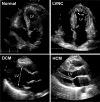Dilated Cardiomyopathy: Genetic Determinants and Mechanisms
- PMID: 28912180
- PMCID: PMC5626020
- DOI: 10.1161/CIRCRESAHA.116.309396
Dilated Cardiomyopathy: Genetic Determinants and Mechanisms
Abstract
Nonischemic dilated cardiomyopathy (DCM) often has a genetic pathogenesis. Because of the large number of genes and alleles attributed to DCM, comprehensive genetic testing encompasses ever-increasing gene panels. Genetic diagnosis can help predict prognosis, especially with regard to arrhythmia risk for certain subtypes. Moreover, cascade genetic testing in family members can identify those who are at risk or with early stage disease, offering the opportunity for early intervention. This review will address diagnosis and management of DCM, including the role of genetic evaluation. We will also overview distinct genetic pathways linked to DCM and their pathogenetic mechanisms. Historically, cardiac morphology has been used to classify cardiomyopathy subtypes. Determining genetic variants is emerging as an additional adjunct to help further refine subtypes of DCM, especially where arrhythmia risk is increased, and ultimately contribute to clinical management.
Keywords: cardiomyopathy, dilated; genetic testing; heart failure; mutation; sarcomeres; therapeutics.
© 2017 American Heart Association, Inc.
Figures







References
-
- Elliott P, Andersson B, Arbustini E, Bilinska Z, Cecchi F, Charron P, Dubourg O, Kuhl U, Maisch B, McKenna WJ, Monserrat L, Pankuweit S, Rapezzi C, Seferovic P, Tavazzi L, Keren A. Classification of the cardiomyopathies: A position statement from the european society of cardiology working group on myocardial and pericardial diseases. European heart journal. 2008;29:270–276. - PubMed
-
- Maron BJ, Towbin JA, Thiene G, Antzelevitch C, Corrado D, Arnett D, Moss AJ, Seidman CE, Young JB. Contemporary definitions and classification of the cardiomyopathies: An american heart association scientific statement from the council on clinical cardiology, heart failure and transplantation committee; quality of care and outcomes research and functional genomics and translational biology interdisciplinary working groups; and council on epidemiology and prevention. Circulation. 2006;113:1807–1816. - PubMed
-
- Bozkurt B, Colvin M, Cook J, Cooper LT, Deswal A, Fonarow GC, Francis GS, Lenihan D, Lewis EF, McNamara DM, Pahl E, Ramachandran VS, Ramasubbu K, Rasmusson K, Towbin JA, Yancy C, American Heart Association Committee on Heart F, Transplantation of the Council on Clinical C, Council on Cardiovascular Disease in the Y, Council on C, Stroke N, Council on E, Prevention, Council on Quality of C, Outcomes R Current diagnostic and treatment strategies for specific dilated cardiomyopathies: A scientific statement from the american heart association. Circulation. 2016 - PubMed
-
- Shore S, Grau-Sepulveda MV, Bhatt DL, Heidenreich PA, Eapen ZJ, Hernandez AF, Yancy CW, Fonarow GC. Characteristics, treatments, and outcomes of hospitalized heart failure patients stratified by etiologies of cardiomyopathy. JACC Heart Fail. 2015;3:906–916. - PubMed
-
- Codd MB, Sugrue DD, Gersh BJ, Melton LJ., 3rd Epidemiology of idiopathic dilated and hypertrophic cardiomyopathy. A population-based study in olmsted county, minnesota, 1975–1984. Circulation. 1989;80:564–572. - PubMed
Publication types
MeSH terms
Substances
Grants and funding
LinkOut - more resources
Full Text Sources
Other Literature Sources
Medical

